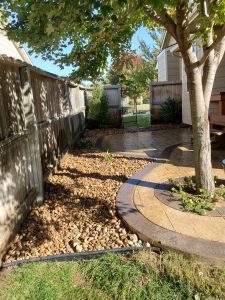Landscape Edging for the Wichita Homeowner
Landscape edging creates clean, crisp lines between beds and other areas. It is most visible between a lawn and the adjoining garden, but edging can define a flower border, a shrub bed, or the transition from a patio to the surrounding garden. It emphasizes the lines of beds, and it leads the eye to the next garden focal point. Simply adding edging to your landscaping can have a dramatic effect on your front yard or back yard!
Landscape Edging Uses
Landscape borders plays important roles in the garden. Most well-designed gardens consist of a series of shapes and forms, each representing an area set aside for a different purpose, such as a vine-covered sitting area or a flower garden. Using landscape curbing accentuates each garden area and defines the shape and form of the overall design.
 From a practical standpoint, landscape edging keeps turfgrass from spreading into surrounding garden areas. At the same time, it prevents soil or mulch from the garden from spilling onto the lawn. Landscape curbing also corrals pathways made of loose material, such as gravel or mulch; it maintains clearly defined walkways while keeping the path materials in place.
From a practical standpoint, landscape edging keeps turfgrass from spreading into surrounding garden areas. At the same time, it prevents soil or mulch from the garden from spilling onto the lawn. Landscape curbing also corrals pathways made of loose material, such as gravel or mulch; it maintains clearly defined walkways while keeping the path materials in place.
Taller edging, such as low hedges or low fencing, can direct garden traffic and keep people on defined paths. Using landscape edging also serves to keep people out of areas where you don’t want them to go, such as planting beds.
If concrete edging is flat and wide enough, it can handle the wheels of a lawn mower. A practical mowing strip created by landscape borders eliminates the need for manicuring the edges with a string trimmer, and it prevents you from mowing over tender plants in beds at the edge of a lawn.
Find out how Citywide can add landscape edging to your home by getting a Free Estimate!


Recent Comments